
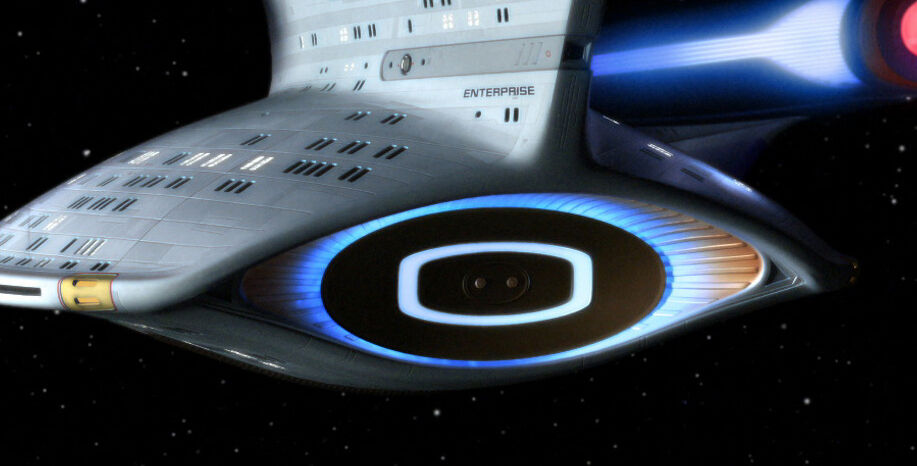


What about the deflector? I mean, isn't that its whole job, to deflect?Carol Freeman
The navigational deflector, also known just as the deflector, the deflector array, the deflector dish, the main deflector, the nav deflector, the parabolic dish, the main sensor, was a component of many starships that was used to deflect space debris, asteroids, microscopic particles, and other objects that might have collided with the ship. At warp speed, the deflector was virtually indispensable for most starships as even the most minute particle could cause serious damage to a ship when it was traveling at superluminal velocities. (VOY: "Alliances", "Collective")
Technical data
The deflector commonly took the form of a dish-shaped force beam generator containing heavy-duty subspace accelerators at the extreme forward end of the vessel's secondary hull. It performed its primary function by emitting low-power deflector shields to deflect microscopic particles and higher-powered deflector beams and/or tractor beams to deflect larger objects. (Star Trek: First Contact; VOY: "Alliances", "Shattered")
On the Constitution-class starships, the navigational deflector was a combined system with the ships' main duotronic sensors. (TNG: "Datalore" computer screen; DS9: "Trials and Tribble-ations" computer screen)
According to Star Trek: The Next Generation Technical Manual (p. 87), the long-range sensor array was a key element of the navigational deflector system as it was used to detect and track objects in the ship's flight path. The deflector beams caused a great deal of subspace distortion, so the sensor arrays were placed in a circular fashion around the deflector beam emitter array.
A deflector's energy could be extended outward to protect other ships. In 2266, the USS Enterprise extended its deflector shield around Harry Mudd's stolen Class J starship, Stella, to temporarily protect it from asteroids while its crew were transported to safety. (TOS: "Mudd's Women") The 24th century Federation starship navigational deflectors could easily deflect laser fire. (TNG: "The Outrageous Okona")
Ordinarily, Federation starships were equipped with a single external deflector dish. In the 2250s these devices were sometimes known as the ships' meteorite beam. (TOS: "The Cage") In the late 24th century, some starships were known to have more than one deflector. One example of this was the Intrepid-class, which had its main deflector located between the extreme forwards of Decks 10 through 13, while the secondary deflector was located on the extreme forward of Deck 6. (VOY: "Caretaker")
The deflector of the USS Enterprise-E was charged with antiprotons while the Borg were modifying it. This proved to be a potential hazard as particle weapons fire hitting the deflector could destroy much of the ship. (Star Trek: First Contact)
In 2384, the location of the front deflector on the USS Dauntless was labeled on the master situation display. Located on Deck A, this deflector was concealed within the hull. (PRO: "Mindwalk")
A clear view of the MSD was provided by Dominique Rossier of Wardenlight Studio. [1]
Later that year, the deflector's location on the USS Voyager-A was labeled in the ship's master systems display. (PRO: "Into the Breach, Part I")
A clear view of the MSD was provided by Dominique Rossier of Wardenlight Studio. [2]
Components of the system
- Booster modulator
- Collimator
- Deflector field
- Emitter array
- Force beam generator
- Induction stabilizer
- Maglock
Other uses
Due to its ability to project a wide variety of energies and particles, the navigational deflector was an extremely versatile piece of equipment. Many starship crews made one-time modifications to the dish to solve several problems they were facing.
USS Cerritos (NCC-75567)
- Ensign Beckett Mariner used radiation from the main deflector in combination with parizene gas to reverse the partial transformation of the USS Cerritos by terraforming emulsion in 2380. (LD: "Moist Vessel")
Cochrane (NCC-74656/04)

- In 2374, the Class 2 shuttle Cochrane fired a polaron pulse from its main deflector in an attempt to shore up the confinement field for the quantum singularity of the relay station that temporarily connected USS Voyager to the Alpha Quadrant. After firing the pulse, the variance in the containment field had been stabilized at 0.29, which was believed to prevent further degradation of the communications signal Voyager was receiving from Starfleet. (VOY: "Hunters")
USS Defiant (NX-74205)
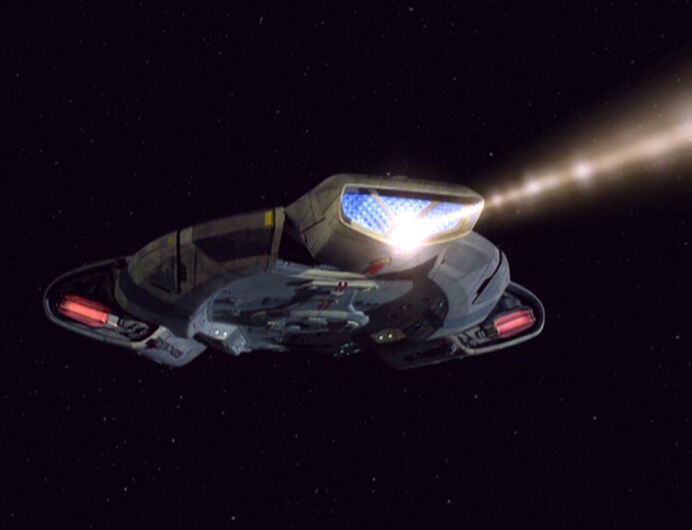
- Navigational deflectors could also be used to emit graviton pulses. (DS9: "Once More Unto the Breach")
- In early-2372, the USS Defiant's deflector was used to shunt an excess amount of warp energy from the ship's warp core that threatened to destroy the ship in a warp core breach. (DS9: "The Visitor")
- During 2372, the deflector of the Defiant was modified in just ten minutes to perform as a single-shot phaser emitter when the ship was under attack from a Jem'Hadar fighter in the atmosphere of a Class J gas giant. Only one shot could be fired with this makeshift phaser emitter as it overloaded with the first shot. (DS9: "Starship Down")
- During the same year, the focal array of the Defiant's navigational deflector was used to generate a subspace tensor matrix in the attempt to create a stable artificial wormhole. (DS9: "Rejoined")
- In 2374, the Defiant used its deflector to fool the numerous externally powered Cardassian orbital weapon platforms defending one of the planets in the Chin'toka system into destroying their own remote power source by projecting a false Federation warp signature onto the power station. (DS9: "Tears of the Prophets")
Enterprise (NX-01)

- In 2154, the navigational deflector of Enterprise NX-01 was used to generate a deflector pulse which destroyed Sphere 41, thus disrupting the entire network of spheres in the Delphic Expanse. Modifications had to be made, however, to prevent the pulse from rupturing EPS conduits throughout the ship. (ENT: "Countdown", "Zero Hour")
Later that year, Enterprise's deflector was modified to emit a positron burst, which disabled Harrad-Sar's barge when it passed through the grappling line of his ship. (ENT: "Bound")
USS Enterprise (NCC-1701)

- The USS Enterprise used a deflector beam to attempt to shift a large asteroid off course when it threatened the planet Amerind in 2268. The attempt failed and caused damage to the ship's power. (TOS: "The Paradise Syndrome")
Stephen E. Whitfield and Gene Roddenberry's The Making of Star Trek (p. 191) stated of the vessel's prominent dish: "The starship's main sensor-deflector (a parabolic sensor and asteroid-deflector) is located at the front end of the secondary hull." In accordance with this, Franz Joseph's Star Trek Blueprints labeled it as the "main sensor and navigational deflector," although Joseph's Star Fleet Technical Manual omitted the latter and referred to it only as the "main sensor." Some Matt Jefferies concept sketches of the ship had earlier included a dome-shaped nosecone "sensor" in place of, or perhaps covering, the dish. (Star Trek Sketchbook: The Original Series, p. 68; The Art of Star Trek, p. 9)
USS Enterprise (NCC-1701-B)

- In 2293, Captains Montgomery Scott and James T. Kirk modified the deflector of the USS Enterprise-B to produce a resonance burst in order to simulate an antimatter explosion when the ship became caught in the Nexus energy ribbon. (Star Trek Generations)
USS Enterprise (NCC-1701-D)
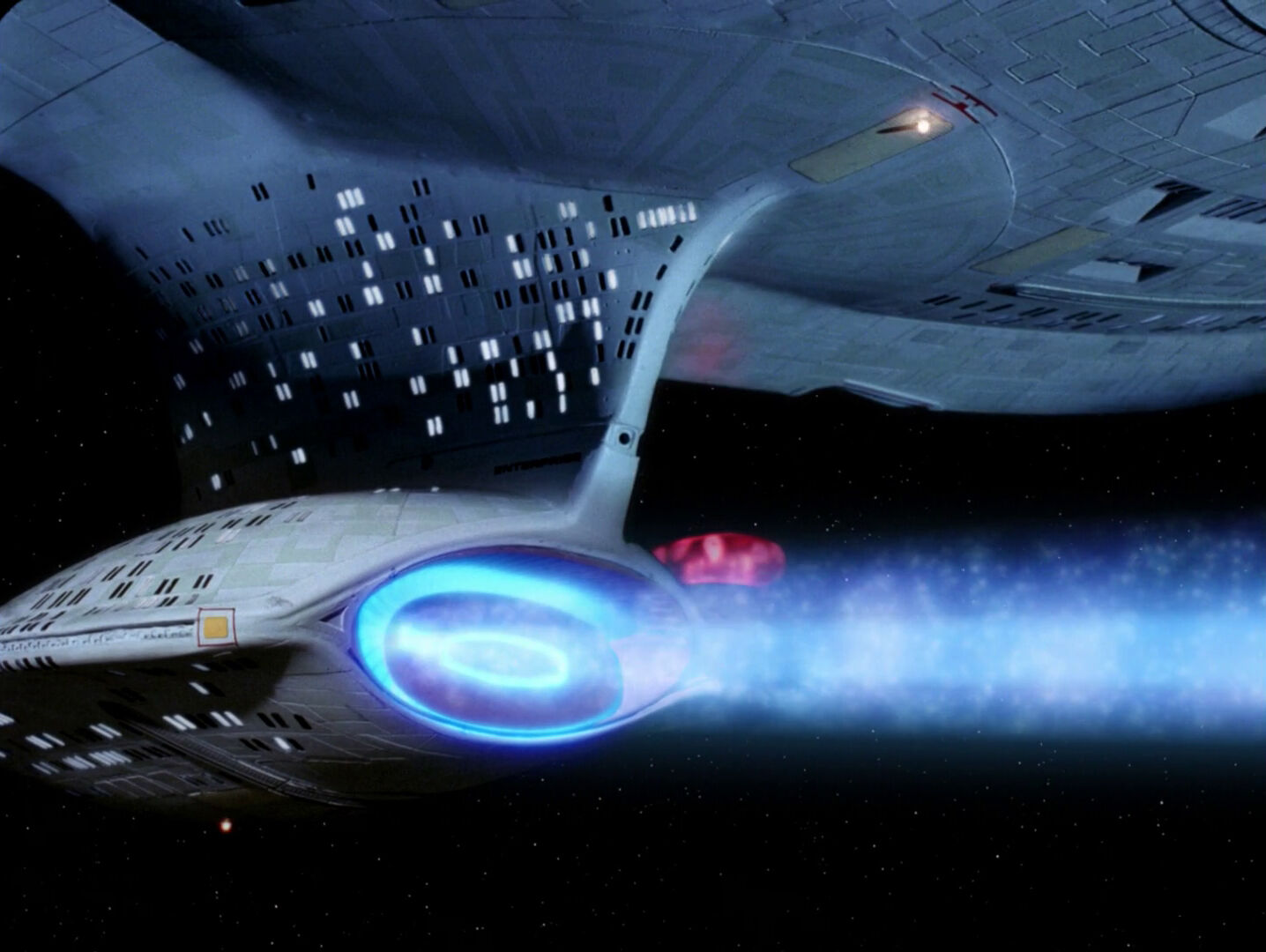
- The crew of the USS Enterprise-D used the deflector to channel an extremely large amount of energy at a controlled rate – both as a weapon against a Borg cube in 2366 and as an energy source hoping to escape a Tyken's Rift in 2367. (TNG: "The Best of Both Worlds", "The Best of Both Worlds, Part II", "Night Terrors") Although the energy beam had a greater power output than the ship's complement of weapons, using the deflector for this purpose was extremely impractical and only ever used on two occasions for three reasons:
- Channeling such a large amount of energy through the deflector made substantial drains on the ship's power systems, notably from the warp engines. This also meant that the beam could only be fired if the ship was traveling at sublight velocities.
- The deflector dish would burn out following the energy beam discharge, requiring extensive repairs, possibly replacement of the deflector altogether.
- The high levels of radiation produced by the energy beam require the evacuation of the entire forward half of the secondary hull and the lower three decks of the saucer section of a Galaxy-class starship.
- Also in 2367, the Enterprise-D's deflector was modified to amplify and reflect the subspace frequencies produced by a cosmic string fragment to change the trajectory of a group of two-dimensional beings that threatened to destroy the ship. (TNG: "The Loss")

- In 2368, the deflector dish was modified to send five beams of light for exactly 8.3 seconds into the clouded atmosphere of Penthara IV, together with a modified phaser blast. This ionized dust particles in the planet's atmosphere, which were converted into high-energy plasma. This plasma was then absorbed by the deflector shields of the Enterprise-D and redirected into space. Warp power had to be rerouted to the deflector dish to create enough energy for the massive undertaking. (TNG: "A Matter Of Time")
- Also in 2368, photon torpedos partially destroyed an asteroid but was unable to destroy the asteroid's core that was that was in danger of colliding with Tessen III, near Starbase 117. A subsequent attempt to use a tractor beam wasn't able to lock on to the asteroid due to magnetic field interference emanating from the asteroid's remaining core materials. Eventually, Picard ordered a particle beam from the deflector dish be used to cause a "disruptive nuclear effect" within the core that caused it to be destroyed. (TNG: "Cost Of Living")
- In three different alternate timelines, the deflector was modified to emit an inverse tachyon pulse to scan beyond the subspace barrier, this being done to ascertain the workings of an anti-time eruption. The convergence of the three tachyon pulse at the same point in space in multiple timeframes caused a paradox which created the eruption in the first instance. (TNG: "All Good Things...")
USS Enterprise (NCC-1701-E)

- A group of Borg attempted to modify the deflector of the USS Enterprise-E to perform as an interplexing beacon so as to contact the Collective of the 21st century. The crew of the Enterprise prevented the attempt by detaching and destroying the deflector. The movement controller unit of the Enterprise-E deflector was labeled "AE-35". (Star Trek: First Contact)
"AE-35" is a reference to 2001: A Space Odyssey, in which the AE-35 unit controls the communication dish's orientation for the Discovery.
According to illustrator John Eaves in a production featurette entitled "The Deflector Dish" included on the second disc of the Special Collector's Edition DVD of Star Trek: First Contact, the original intention was for Picard to manually reconfigure one of the ship's external weapon emplacements to eliminate the Borg beacon, but Michael Okuda advised against this tactic, contending that there would be "too much volatile equipment and materials in that area; it would destroy the ship." Okuda's concern was reflected in subsequent rewrites by having the characters take the alternate approach of detaching the dish, citing the danger.
Nevertheless, it remains unspecified in the final film as to whether the dish being "charged with antiprotons" was a normal operating condition or a result of the Borg's modifications. In "Threshold", B'Elanna Torres said the only component of the USS Voyager which generated antiprotons was its warp core, and yet such particles (presumably so generated) could also be emitted from the ship, per "The Q and the Grey". While not specified in that episode, the navigational deflector's particle emitter would seem an appropriate means of accomplishing this.
As evidenced by a call sheet from Star Trek: First Contact, live-action footage of the deflector array was filmed on Paramount Stage 15.
In "The Deflector Dish" featurette, production designer Herman Zimmerman confirmed this location, and elaborated on the set's construction: "We took the biggest stage on the lot, Stage Fifteen, and it was just barely big enough... I actually made the deflector dish about seven eighths actual size. I don't think the audience was cheated from what the size should have been, but that was a difficult thing to proportion... that whole set was made of plastic with lights inside it, and had to do a lot of different things, including separate... about twenty feet of the actual rise was done physically with the Borg actors on it, and the piece actually leaving the base that it's mounted to, and going up toward the stars."
Producer and writer Rick Berman further recalled: "I remember at first, we were pretty disappointed that we couldn't build the deflector array as big as we wanted to. There were restrictions on the size and the height that we could get up to... we were bummed out a little bit, because it wasn't as big as we wanted it to be."
USS Odyssey (NCC-71832)
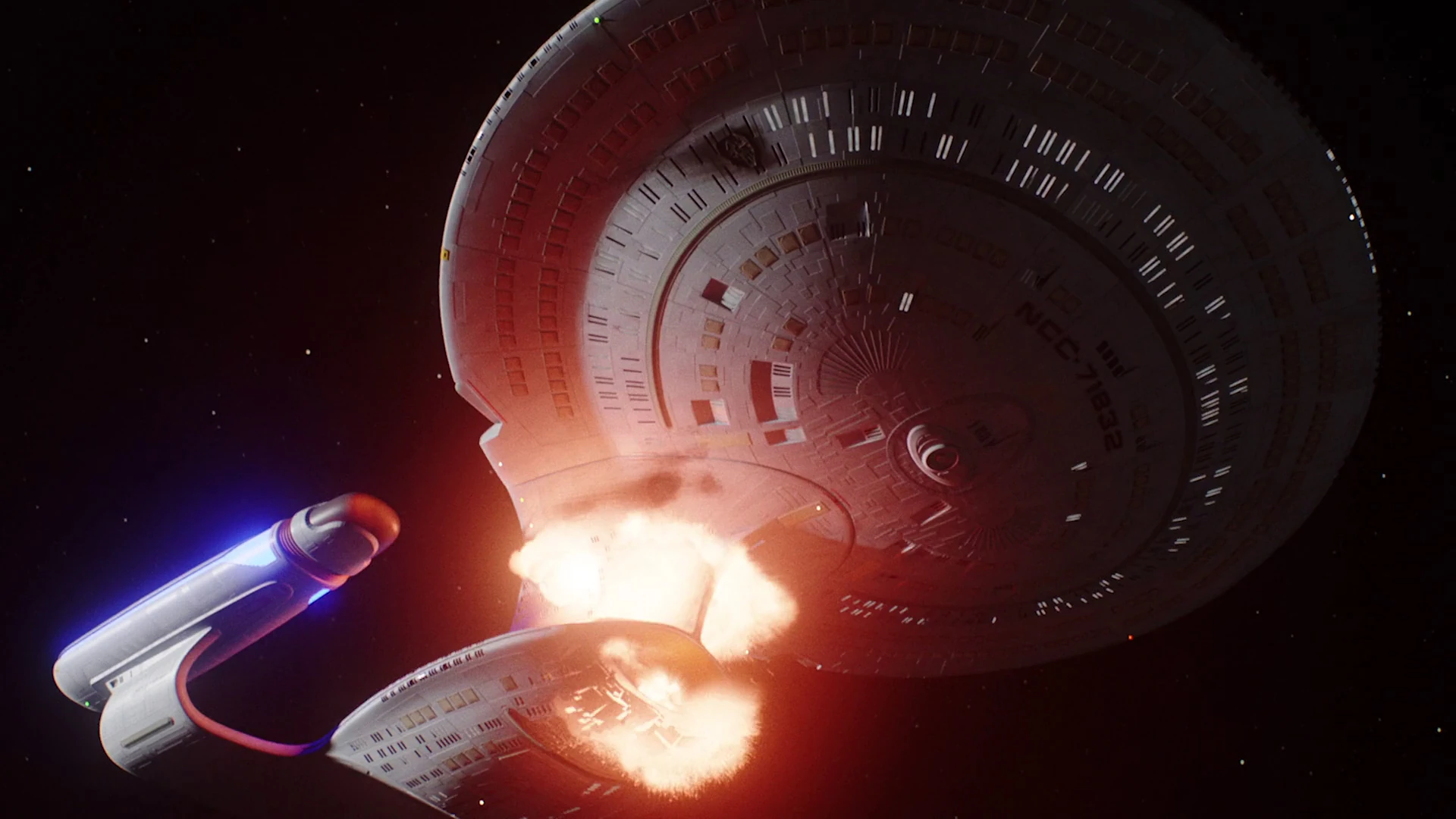
- A suicide run on the navigational deflector of the USS Odyssey in 2370 caused a chain reaction resulting in the ship's destruction. (DS9: "The Jem'Hadar")
USS Voyager (NCC-74656)
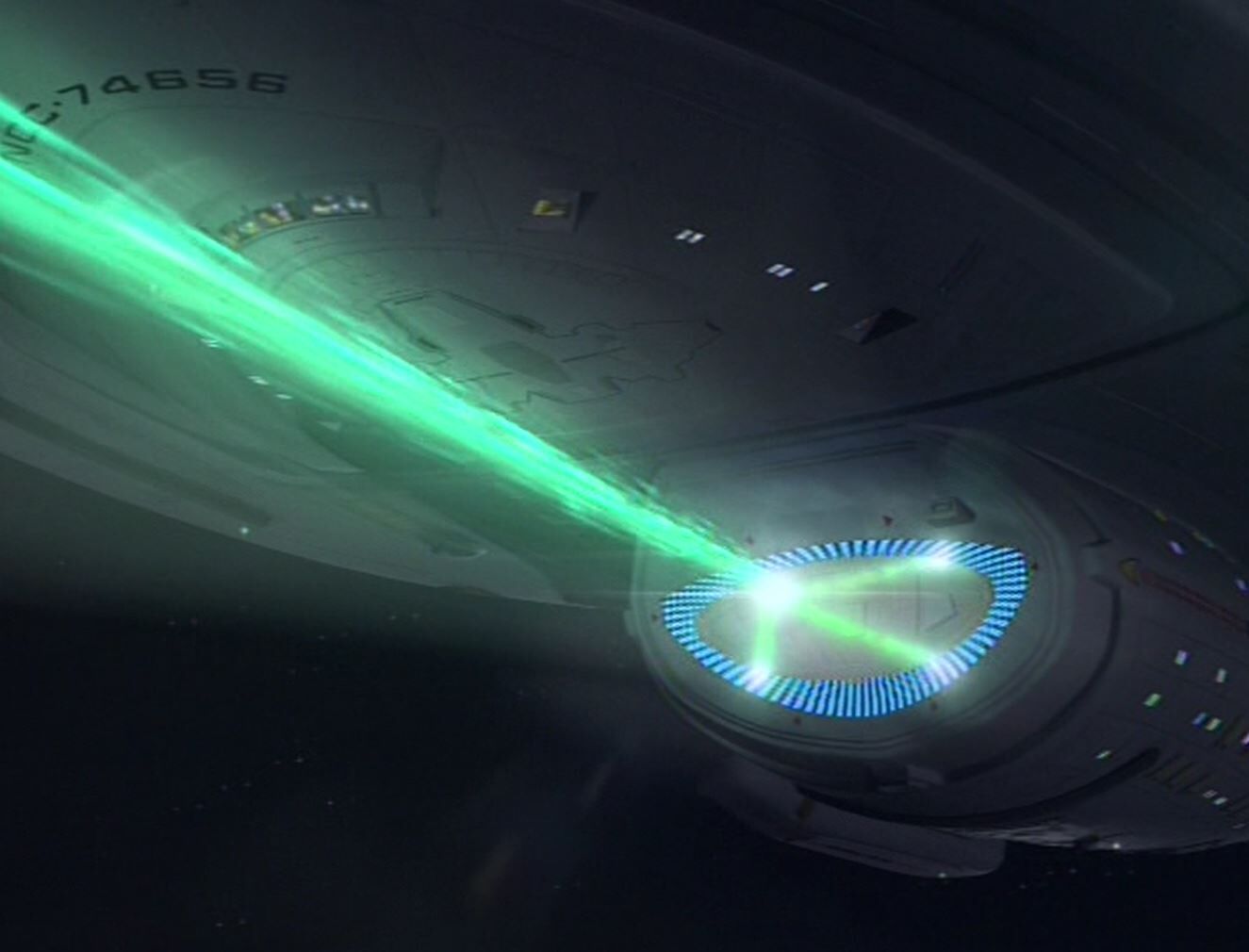


- In 2371, the crew of the USS Voyager modified the ship's main deflector to emit a dampening field and warp particles diverted from the nacelles, along with a dekyon beam. The navigational array was also part of an analysis for possible issues in regards to being stuck in a type-4 quantum singularity. (VOY: "Parallax")
- During the same year, the deflector was used to emit an inverted magnetic pulse to drive off a swarm of space-dwelling lifeforms. (VOY: "Elogium")
- In 2372, the transporter signal was boosted on board Voyager by re-routing the transporters directly through the deflector. (VOY: "Non Sequitur")
- During the same year, Voyager's deflector was used to fire dozens of radion beams to conceal a transporter signal into one of the beams. (VOY: "Resistance")
- In 2374, the ship's main deflector was modified by Seven of Nine to generate resonant graviton beams to open a quantum singularity into fluidic space. (VOY: "Scorpion, Part II")
- During the same year in an alternate timeline, a heavily damaged Voyager lost the capabilities of its navigational deflector array along with many other systems during the Year of Hell. Encountering a moving micrometeoroid field, they were unprotected without their deflector and the ship began suffering even more damage. Captain Janeway restored the navigational deflector field, although she was burned due to a massive fire in Deflector Control. This timeline was negated when the Krenim weapon ship was deleted from history. (VOY: "Year of Hell, Part II")
- In 2375, Chakotay was able to induce a paralateral rentrillic trajectory for the ship as a way out of chaotic space by routing Voyager's sensor array through the ship's deflector dish, thereby increasing the deflector's amplitude. (VOY: "The Fight")
- Before her time on Voyager, B'Elanna Torres used a deflector array combined with a holoemitter to project a starship into space. (VOY: "Prototype")
- The Borg "children" used a tractor beam in an attempt to steal Voyager's main deflector, to use it as an interplexing beacon for contacting the Borg. (VOY: "Collective")
- Chakotay used the deflector as a "lightning rod" to stop Voyager from being fractured into different time periods by a temporal anomaly. The strike burned out the deflector dish, though Chakotay said doing so was "better than the alternative." (VOY: "Shattered")
- In 2378, Voyager used an anti-tachyon pulse to seal a temporal rift, which had been generated by Janeway's counterpart from an alternate 2404. (VOY: "Endgame")
Appendices
Background information
The conceptual origins of the navigational deflector, in common with those of several other key Star Trek devices including shields, phasers, and tractor beams, can be traced to notes compiled by Gene Roddenberry through "discussion with various scientists" while writing the first pilot in 1964, and subsequently circulated among production staff, as reproduced in Roddenberry and Stephen E. Whitfield's The Making of Star Trek (p. 86): "Some kind of 'meteoroid shield' or 'meteoroid force field deflector' will be necessary in true spaceships. If not a force field, it may be a magnetic field which deflects cosmic dust or small meteoroids via an opposite charge. Or it might consist of a probing Laser beam which deflects and/or destroys dust and small particles from the path of the ship."
By the time of its third revision in April 1967, the Writers/Directors' Guide for Star Trek: The Original Series (p. 21) specified under the general heading of "DEFLECTORS" that, in addition to its deflector screen, "the ship also has 'navigational deflector beams' which, guided by 'navigational scanners', sweep out far ahead of the vessel's path through space, deflecting from the ship's course meteoroids, asteroids, or space debris and other objects which would cause damage should the vessel strike them at this enormous speed. These are all fully automated, operated by the vessel's computers."
In an internal production document they entitled the Star Trek: Voyager Technical Guide Version 1.0 (p. 22), Rick Sternbach and Michael Okuda emphasized that the vessel's "DEFENSIVE SHIELDS" were "distinctly different from the NAVIGATIONAL DEFLECTOR."
External link
- Navigational deflector at Memory Beta, the wiki for licensed Star Trek works